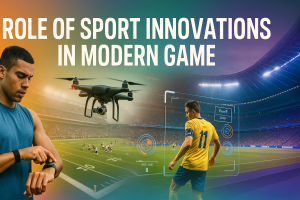
Introduction
Sports have always been a source of entertainment, excitement, and community. However, in recent years, technology has played a huge role in shaping how sports are played, viewed, and experienced. From wearable tech to smart equipment, 2025 is set to be a year of significant sports innovations that will transform the games we love.
In this article, we will explore the top sports innovations and goal setting expected to shape 2025 and beyond. These innovations will enhance real world sports performance, improve fan engagement, and push the boundaries of what’s possible in professional sports.
What Are Sports Innovations?

Sports innovations refer to new ideas, technologies, and advancements that improve how sports are played, watched, and understood. These innovations can range from game-changing equipment to advanced performance tracking tools and even fan engagement technologies. Innovations in sports high quality technology aim to make games more exciting, players’ performance more precise, and fans’ or customers’ experiences more immersive.
As we move closer to 2025, these innovations will continue to redefine the sports world, making it more connected, dynamic, and data-driven.
Benefits of Sport Innovations
Using new tech in sports brings many clear gains for everyone involved. Wearable sensors now warn trainers when a player shows signs of fatigue or a possible injury, so they can rest sooner. Real‑time data helps coaches adjust tactics during a match, such as making key substitutions at just the right moment. VR training lets players repeat plays in a safe digital space, speeding up learning without extra wear on the body. Fans get richer game experiences through apps that show live scores, custom camera angles, and player stats on demand. Teams and leagues can sell targeted ads or merch based on what fans watch most closely. Even amateur athletes and small clubs benefit, since low‑cost versions of these tools are now on the market. Overall, these advances boost performance, cut injuries, and make sports more fun and accessible.
Role of Sport Innovations in Modern Game

Today, technology sits at the heart of sports from start to finish. Before a game, coaches study detailed reports on each athlete’s fitness, sleep, and past injuries to set training loads. During play, live data streams guide in‑game decisions, from play calls to pacing. Referees use video replay systems with clear slow‑motion views to make fair calls. Broadcasters and streaming platforms layer in stats, biometric readings, and heat maps to keep fans informed. Stadiums use smart lighting and sound systems that react to big plays, making live events more exciting. Media rights and sponsors tap into these streams to place ads where they matter most. In essence, innovations weave into every step—training, planning, refereeing, broadcasting, and fan engagement—creating a seamless sports ecosystem.
Top Sports Innovations 2025

1. Wearable Technology in Sports
One of the biggest changes in sports recently has been the rise of wearable technology. Devices like fitness trackers, smartwatches, and wearable sensors are now used by athletes and casual fans alike.
Why It Matters: Wearable tech allows athletes to track their performance, health, and recovery. These devices’ features include the ability to monitor things like heart rate, sleep, movement, and muscle strain. In 2025, expect even better devices that give more detailed insights into performance.
Example: Whoop and Fitbit are popular fitness trackers that give athletes useful data to help them improve. Expect more advanced devices to hit the market in 2025.
Tip: If you’re an athlete, using wearable tech is a smart way to track your progress and stay in top shape.
2. Smart Equipment for Precision and Accuracy
Another big innovation in sports is smart equipment. These are tools like smart basketballs that measure speed and accuracy or smart tennis rackets that track every swing.
Why It Matters: Smart equipment helps athletes track their technique and performance. This performance management solution allows for better training and more precise feedback. It’s a game-changer for both professionals and amateurs.
Example: Smart tennis rackets use sensors to track how hard the ball is hit and at what angle, helping players improve their swings. Expect even more smart equipment to be available in 2025.
Tip: Using smart gear can help you measure your performance more accurately, improving your game.
3. Virtual Reality (VR) and Augmented Reality (AR) for Training
Virtual Reality (VR) and Augmented Reality (AR) are changing how athletes train. VR allows athletes to experience game situations in a virtual setting, while AR can provide real-time data during training.
Why It Matters: These technologies help athletes prepare for real-life situations. They can practice complex game scenarios without the pressure of actual competition. Plus, fans can experience games in new ways using AR and VR.
Example: VR is already being used by some teams to simulate game situations for training. Fans can also use VR to experience games from the player’s perspective.
Tip: If you want to improve your skills, using VR for training can give you a competitive edge. It’s also great for fans who want an immersive experience.
4. Data Analytics for Improved Performance
Data analytics is another game-changing innovation. Athletes, coaches, and teams are using data collection, data processing, data integration, data profiling techniques, and big data to improve performance and create better strategies.
Why It Matters: Data analytics helps teams make decisions based on real data, not just instinct. It’s used to track performance, measure strengths, and find weaknesses. In 2025, data set analytics will be even more detailed, helping teams and athletes perform better.
Example: In basketball, teams use data sources to track every shot, every move, and every player’s position to create the best strategies. Data analytics is changing how games are played.
Tip: Athletes can use big data analytics for performance management process to understand their strengths and weaknesses, improving their performance over time.
5. Fan Engagement Through Streaming and Social Media
In 2025, fan engagement will be better than ever. Streaming services and social media allow fans to interact with their favorite teams and athletes in new ways.
Why It Matters: Fans will have access to live games, exclusive behind-the-scenes content, and direct interaction with players. It’s a more personalized and exciting experience, both for watching games and for staying connected with the sports world.
Example: Platforms like Twitch and YouTube let fans watch games live or enjoy exclusive content. In 2025, we can expect even more ways to interact with the action, as with continuous feedback on what fans like more.
Tip: To stay connected with your favorite teams, follow them on social media for the latest updates and exclusive content.
Future of Sports Innovations Beyond 2025

Looking ahead, sports tech will get more personal and immersive. AI machine learning and performance management tools may craft training plans and set goals based on each athlete’s unique data profile and review processes. Fans might use augmented reality (AR) glasses to see real‑time stats overlaid on the field and 360-degree feedback. Smart stadiums could adapt lighting, sound, and even temperature to match crowd energy. Advances in bioengineering may speed up injury recovery while keeping play safe. Through each new leap, performance management systems and innovation will keep transforming how we train, compete, and cheer for our favorite teams.
Comparative Table: Top Sports Innovations in 2025
| Innovation | Why It Matters | Example |
|---|---|---|
| Wearable Technology | Monitors performance and health in real-time | Whoop and Fitbit for tracking fitness metrics |
| Smart Equipment | Tracks technique, speed, and accuracy | Smart tennis rackets and soccer balls |
| VR & AR for Training | Enhances training and fan experiences | VR training systems for simulating game situations |
| Data Analytics | Provides insights into performance and strategy | Data-driven decisions in basketball and football |
| Fan Engagement | Increases fan interaction via streaming and social media | Twitch, YouTube, and exclusive content |
Conclusion: The Future of Sports in 2025
In 2025, sports will continue to evolve thanks to innovative technologies. Wearable tech, smart equipment, VR, AR, and data analytics will help athletes perform better, while fans will experience games in more interactive and exciting ways. Whether you’re an athlete looking to improve or a fan wanting a more immersive experience, 2025 will be a year of exciting changes in the world of sports.
Call to Action
Want to stay up-to-date with the latest sports innovations? Visit our website for more insights and updates on the future of sports technology in 2025.










